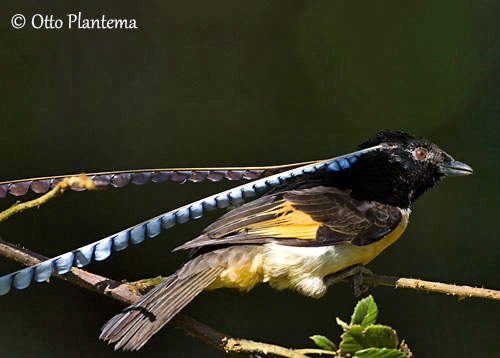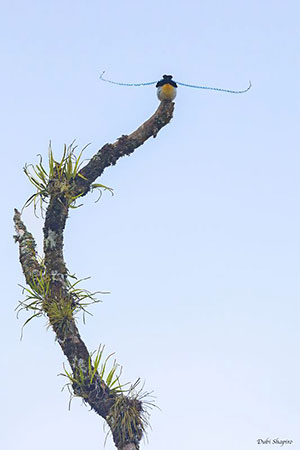
Fr: Paradisier du Prince Albert
Ang: King-of-Saxony Bird-of-paradise
All: Wimpelträger-Paradiesvogel
Esp: Ave del paraíso de Alberto
Ita: Uccello del paradiso del re di Sassonia
Nd: Wimpeldrager
Sd: flaggbärare
Photographers:
Otto Plantema
Trips around the world
Dubi Shapiro
Dubi Shapiro Photo Galleries
Text by Nicole Bouglouan
Sources:
HANDBOOK OF THE BIRDS OF THE WORLD Vol 14 by Josep del Hoyo-Andrew Elliot-David Christie - Lynx Edicions – ISBN: 9788496553507
Les Oiseaux de paradis – Histoire Naturelle et photographies - par Michel Ottaviani - Editions Prin, France – ISBN : 2-909136-40-X
Birds of Paradise and Bowerbirds De Phil Gregory – Editeur: Bloomsbury Publishing, 2020 – ISBN: 1472975847, 9781472975843 – 416 pages
Birds of New Guinea: Second Edition De Thane K. Pratt, Bruce M. Beehler – Editeur: Princeton University Press, 2014 – ISBN: 0691095639, 9780691095639 – 528 pages
Birds of New Guinea: Distribution, Taxonomy, and Systematics De Bruce M. Beehler, Thane K. Pratt – Editeur: Princeton University Press, 2016 – ISBN: 069116424X, 9780691164243 – 672 pages
Book of Curious Birds De Jennifer Cossins – Editeur: Hachette UK, 2021 – ISBN: 073442048X, 9780734420480 – 64 pages
Astonishing Animals: Extraordinary Creatures and the Fantastic Worlds They ... De Tim Flannery – Editeur: Open Road + Grove/Atlantic, 2012 – ISBN: 0802194176, 9780802194176 – 192 pages
Bird: The Definitive Visual Guide De DK – Editeur: Dorling Kindersley Ltd, 2022 – ISBN: 0241596319, 9780241596319 – 512 pages
Animal Diversity Web (University of Michigan Museum of Zoology)
King of Saxony – The Bird-of-Paradise
CREAGUS@Monterey Bay (Don Roberson)
Fatbirder - The World’s Richest Information Resource about Birds for Birders
Wikipedia, the free encyclopaedia
King of Saxony Bird-of-paradise
Pteridophora alberti
Passeriformes Order – Paradisaeidae Family
INTRODUCTION:
The King-of-Saxony Bird-of-paradise is the only member of the genus Pteridophora. It is endemic to the Central Ranges of New Guinea where it frequents montane forest and edges, between 1,500 and 2,750 metres of elevation. It feeds primarily on fruits, but insects and spiders are also part of its diet.
Male and female have very different plumages. The female has very cryptic appearance whereas the male has brightly-coloured black and yellow plumage, and two stiff plumes of up to 50 centimetres long above the eyes that move around when the bird is displaying.
The polygynous male performs spectacular displays while singing, perched on exposed bare branches or more concealed sites among foliage. The female builds and tends the nest alone.
The name of this species pays tribute to the German King of Saxony, Albert of Saxony.
The King-of-Saxony Bird-of-paradise is hunted for its long plumes used for ceremonial purposes by natives. However, it is common throughout the range and the species is not globally threatened.

DESCRIPTION OF THE BIRD:
Biometrics:
Length: M: 22 cm – F: 20 cm
Weight: M: 80-95 g – F: 68-88 g
The King-of-Saxony Bird-of-paradise adult male has velvety black head, mantle and back, with iridescent sheen of bronze-green, especially on the elongated feathers of the mantle. Rump, uppertail-coverts and tail are black with dark brown wash. The upperwing is similar but both exposed bases and broad leading edges of secondaries are cinnamon like the primaries, except the outer two primaries.
On the underparts, chin and throat are velvety black, but a faint breast shield is formed by the iridescent green-blue to purple narrow tips of feathers, at centre and lower border of the black throat.
Rest of underparts are dark yellow, brighter on the breast but paler and duller on vent and undertail-coverts. The flanks are whitish.
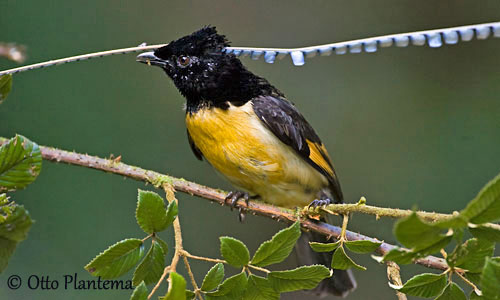
On the black head, the bird has two long, scalloped, enamel-blue brow-plumes, one behind each eye. This is a uniquely modified occipital plume of up to 50 centimetres long, of bare central feather shaft with 40-50 flag-like structures placed only on the outer side. The upper surface is enamel-blue whereas the underside is red-brown.
These plumes can be independently erected at the bird will. The skull of this species has small depressions behind the occipital cavity where is the essential musculature that controls these elongated plumes.
The bill is black, with aqua-green mouth. The eyes are dark brown. Legs and feet are dark brown-grey.
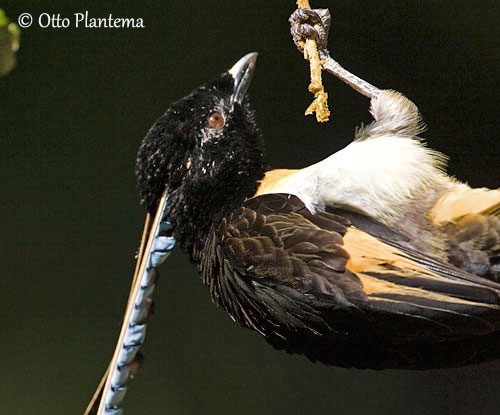
The female (not displayed) has cryptic plumage with grey to sooty grey most of head and entire upperparts, but browner on the lower back.
On the underparts, chin, throat and neck sides are buffy grey with dark, brownish-grey barring. Breast to vent is whitish with blackish-brown chevrons. The undertail-coverts are ochraceous.
The juvenile is not described.
The immature male resembles adult female but it is duller and the eyes are red-brown.
The subadult male varies with some feathers of adult male plumage. The black nasal tuft feathering is the first sign of the adult plumage.
RANGE:
The King-of-Saxony Bird-of-paradise has two main ranges running in a south-east line, from the Weyland and Snow Mountains eastwards, to the Bismarck and Kratke Ranges, following the main tectonic division of the island.
HABITAT:
The King-of-Saxony Bird-of-paradise is native to the rainforest regions of New Guinea. It is present in the mountains, from 1,500 to 2,750 metres of elevation, generally between 1,800 and 2,500 metres.
The species is able to adapt to lightly disturbed patches of rainforest and forest edges, clearings and tracks.
CALLS AND SONGS: SOUNDS BY XENO-CANTO
The male’s song is described as a radio-static hiss. The advertising song is a dry rattling jumble of insect-like notes given at rapid pace, which briefly turns into a chirp at the climax.
While displaying, the male produces hissing sounds including soft, high-pitched clucks, chatters, mews and squeaks. The adult male also sings to compete with rivals in adjacent territories. The male performs elaborate movements with the elongated occipital plumes while singing.
The calls given by immature males are described as noisy, descending “churr”.
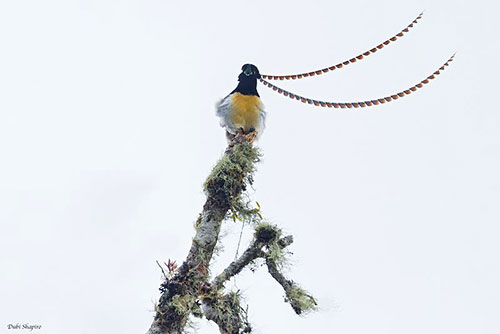
BEHAVIOUR IN THE WILD:
The King-of-Saxony Bird-of-paradise is primarily frugivorous and tends to favour green fruits and especially “false figs” and drupes (those of Timonius belensis). It also eats insects and arthropods, probably depending on the season.
The males forage mainly in the upper canopy, whereas females and young males (with female-like plumage) may forage at all levels of the forest.
This species forages generally alone, except at good feeding sites where 3-4 individuals can be seen together. They search for invertebrates by tearing and probing at mosses or lichens. They forage along mossy branches and in epiphytes, also at flowers and fruits.
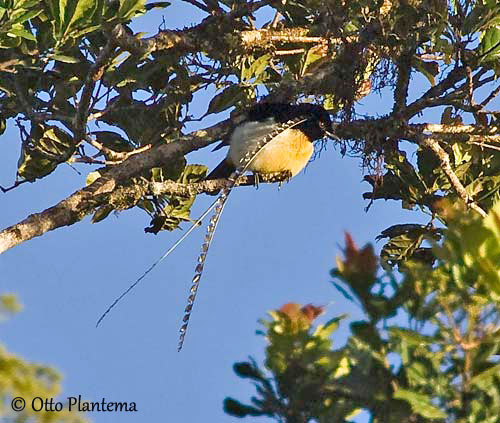
The King-of-Saxony Bird-of-paradise adult male is polygynous. It performs a very spectacular, rhythmic, bouncing display. Each male usually displays in its own spot, but several males are often displaying in a large area to attract females. They are territorial and guard their territory, and sing to compete with neighbour rivals.
The courtship displays of the King-of-Saxony Bird-of-paradise include several phases. The male sings while perched on exposed forest canopy perch to attract females.
When a female approaches, the male moves its occipital plumes and often erects the feathers of both mantle and breast shield. Then, it flies down to reach a vine in the understorey to invite the female.
Here, the male bounces vigorously to vibrate the vine which in turn, also bounces the female which is perched 50 centimetres above the male. But if the female interest declines, the male performs infantile wing-shivering with leg-flexing to re-stimulate it.
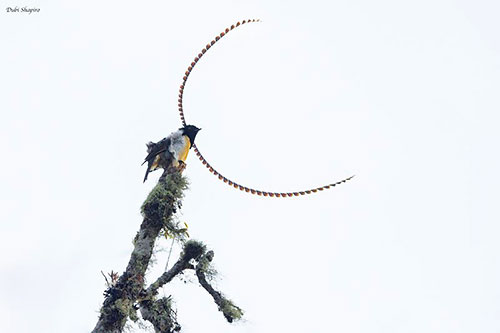
The perch-bouncing display is followed by another behaviour during which the male hops stiffly up to the female. The feathers of both mantle and breast shield are raised, and the male rotates the upper body while moving its head side-to-side. At this moment, the raised long, enamel-blue plumes swirl about, prior to copulation. When approaching the female, the male wags the head from side-to-side while hopping up the vine.
After mating, the female leaves whereas the male returns to the perch and displays again to attract another female.
The female alone performs all the nesting duties.
The King-of-Saxony Bird-of-paradise is probably resident within its range.
The birds of paradise moving over long distance usually perform a distinctive undulating flap-and-glide action, with the wings held closed against the body while rising in the air, interspersed with bouts of flapping.
When the King-of-Saxony Bird-of-paradise is flying, the long occipital plumes are waving behind its head.
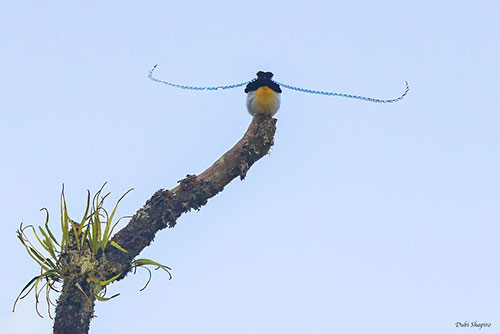
REPRODUCTION OF THIS SPECIES:
Breeding is possible year-round, with peak in July-February.
The female builds the nest alone, a shallow open cup made of fine stems of epiphytic orchids and fresh green fern fronds. The cup is lined with same material or tendrils. This description is that of a single nest placed 10-11 metres above the ground in branch fork in Timonius belensis tree.
Only one egg is laid per clutch. The incubation by the female alone appears to last more than 22 days.
The chick hatches and remains altricial for some time before fledging, but the duration of both nestling and fledging periods is unknown. However, in most species of this family, the young fledge within 20 and 30 days after hatching.
PROTECTION / THREATS / STATUS:
The King-of-Saxony Bird-of-paradise is described as widespread and common.
The species is affected by hunting pressure. The males are hunted for their highly prized long plumes, used by natives for ceremonial ornaments. On the other hand, eggs and chicks may be preyed on by arboreal snakes or other birds.
The size of the population is unknown, but it is suspected to be declining.
However, the species is not globally threatened and the King-of-Saxony Bird-of-paradise is currently evaluated as Least Concern.
